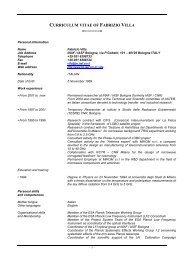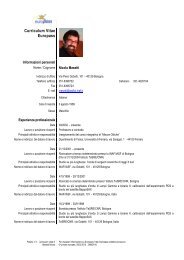booklet format - inaf iasf bologna
booklet format - inaf iasf bologna
booklet format - inaf iasf bologna
You also want an ePaper? Increase the reach of your titles
YUMPU automatically turns print PDFs into web optimized ePapers that Google loves.
Temporal Data Analysis A.A. 2011/2012<br />
Proof.<br />
3.3.3 Autocorrelation<br />
H j = 1 N<br />
= 1 N<br />
= 1 N<br />
Here we have {g k } = {f k }, which leads to<br />
N−1 ∑<br />
k=0<br />
N−1<br />
∑<br />
l=0<br />
N−1<br />
∑<br />
l=0<br />
1<br />
N<br />
N−1 ∑<br />
l=0<br />
1<br />
N−1 ∑<br />
f l<br />
N<br />
k=0<br />
f l G ∗ j W −j l<br />
N<br />
f l g ∗ l+k W −k j<br />
N<br />
g ∗ l+k W −k j<br />
N<br />
= F j G ∗ j<br />
and<br />
h k ≡ (f ⋆ f ) k = 1 N<br />
N−1 ∑<br />
l=0<br />
f l × f ∗<br />
l+k<br />
(3.24)<br />
{f k } ↔ {F j }<br />
{h k } = {(f ⋆ f ) k } ↔ {H j } = {F j × F ∗ j } = {|F j | 2 }<br />
(3.25)<br />
In other words: the Fourier transform of the autocorrelation of {f k } is the modulus squared of<br />
the Fourier series {F j } or its power representation.<br />
3.3.4 Parseval Theorem<br />
We use (3.24) for k = 0, that is h 0 , and get on the one side:<br />
h 0 = 1 N<br />
N−1 ∑<br />
l=0<br />
|f l | 2 (3.26)<br />
On the other hand, the inverse trans<strong>format</strong>ion of {H j }, especially for k = 0, results in (see (3.11b))<br />
Put together, this gives us the discrete version of Parseval theorem:<br />
1<br />
N<br />
N−1 ∑<br />
h 0 = |F j | 2 (3.27)<br />
N−1 ∑<br />
l=0<br />
j =0<br />
|f l | 2 N−1 ∑<br />
=<br />
j =0<br />
|F j | 2 (3.28)<br />
52 M.Orlandini

















